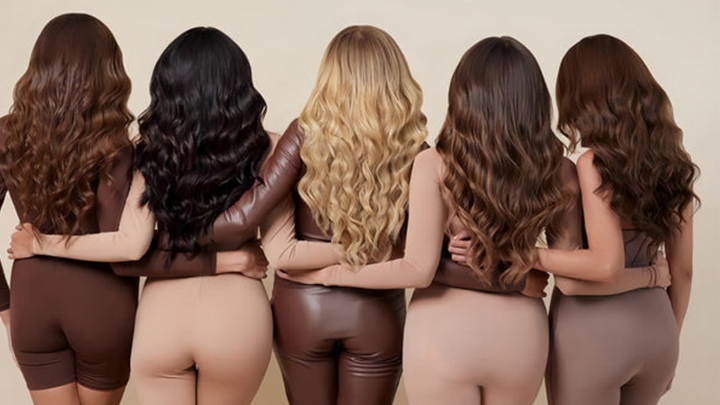Does Your Wig Need Washing? A Guide to Wig Care and Maintenance
Wigs, like natural hair, require proper care to maintain their appearance, longevity, and hygiene. Whether your wig is made of synthetic fibers or human hair, washing it regularly is essential to keep it looking fresh, clean, and vibrant. In this article, we will explore why wigs need to be washed, how often to wash them, and the best practices for cleaning wigs without damaging them.
1. Why Should You Wash Your Wig?
Wigs, just like natural hair, accumulate oils, dirt, dust, and product buildup over time. This can affect the wig’s appearance, making it look dull, greasy, or frizzy. Regular washing helps:
- Remove Dirt and Oils: Oils from your scalp, sweat, and environmental pollutants can transfer to the wig, especially at the hairline and cap. Washing the wig will remove this buildup, keeping it clean and hygienic.
- Restore the Wig’s Appearance: Washing revives the fibers, whether synthetic or natural, helping the wig maintain its original shape, texture, and shine.
- Extend the Wig’s Lifespan: Proper care, including washing, ensures that the wig remains in good condition for longer, preventing tangling, matting, or fiber damage.
2. How Often Should You Wash Your Wig?
The frequency of washing depends on several factors, including the type of wig, how often you wear it, and the environment you are in.
- Synthetic Wigs: These wigs should generally be washed every 10 to 15 wears, or once they start to look dull or have a noticeable buildup of styling products.
- Human Hair Wigs: Human hair wigs can be washed less frequently, typically every 6 to 8 wears. However, if you use styling products often or wear the wig daily, you may need to wash it more frequently.
- Wigs Worn Daily: If you wear your wig every day, you may need to wash it every 1 to 2 weeks. If you wear it occasionally, washing it once a month may suffice.
Additionally, factors like sweat, humidity, and exposure to smoke or strong odors may require more frequent washing.
3. How to Wash Your Wig Properly
Washing a wig involves more care than washing natural hair, as wigs are more delicate. Here’s a step-by-step guide to washing both synthetic and human hair wigs:
Step 1: Detangle the Wig
Before washing, use a wide-tooth comb or a wig brush to gently detangle the wig, starting from the ends and working your way up to the roots. This will prevent knots and minimize shedding during washing.
Step 2: Use Wig-Specific Shampoo
Always use a shampoo designed specifically for wigs. Regular shampoos can be too harsh and strip the wig’s fibers, especially for synthetic wigs. For human hair wigs, choose a sulfate-free shampoo that is gentle on the hair.
Step 3: Soak the Wig
- Fill a basin with cool water (never hot, as heat can damage the fibers).
- Add a small amount of wig shampoo and mix it into the water.
- Submerge the wig in the water, gently swirling it around. Avoid rubbing, scrubbing, or twisting the wig, as this can tangle or damage the fibers.
- Let the wig soak for about 5 minutes.
Step 4: Rinse
- After soaking, rinse the wig under cool running water until all the shampoo is completely removed. Be sure to rinse thoroughly, especially at the cap and roots, to prevent any leftover residue.
Step 5: Condition the Wig
- Apply a wig-friendly conditioner to the lengths of the wig, avoiding the roots or cap (especially for synthetic wigs, as it can loosen the fibers).
- Leave the conditioner on for a few minutes before rinsing it off with cool water.
Step 6: Air-Dry the Wig
- After rinsing, gently squeeze out excess water without wringing or twisting the wig.
- Place the wig on a towel to blot the remaining water.
- Let the wig air-dry on a wig stand to maintain its shape. Avoid using a blow dryer or placing it near direct heat sources, as this can damage both synthetic and human hair wigs.
4. Additional Tips for Wig Care
- Avoid Over-Washing: Washing your wig too frequently can wear down the fibers, causing it to lose its shine and texture more quickly.
- Minimize Heat Exposure: For synthetic wigs, never use heat-styling tools unless the wig is labeled as heat-resistant. For human hair wigs, always use a heat protectant when styling with heat tools.
- Proper Storage: Store your wig on a wig stand or in a breathable bag to protect it from dust and tangling when not in use.
- Use Wig Care Products: Sprays and leave-in conditioners designed for wigs can help keep them soft, manageable, and shiny between washes.
5. Conclusion
In conclusion, wigs, whether synthetic or human hair, need regular washing to maintain their cleanliness, appearance, and longevity. By following proper washing techniques and using wig-friendly products, you can ensure your wig stays fresh and vibrant, enhancing your overall look and confidence. With the right care, your wig will look as beautiful as the first day you wore it!




